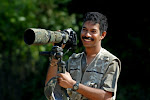Centipede’s Baby care.
Parental care is an essential part of human life, because we take an exceptionally long time to grow up. Other mammals also care for their young, protecting them, feeding them on milk. But in the rest of animal world, especially in small insect world, family styles vary from one species to another.
Most insects are orphans at birth. Their parents have died soon after the mating and after the depositing of eggs. Even if the majority of insects never live long enough to see their offspring, but they still, never neglect them. Female does everything possible for the safety of her young that she is never able to see. Fe males deposits eggs in such perfect places as give maximum protection from predators, adverse climatic conditions and enable the freshly hatched larvae to find food without any difficulty. In butterflies eggs are always laid on or very near to the larval food plant as they feed only on that particular species of the tree.
males deposits eggs in such perfect places as give maximum protection from predators, adverse climatic conditions and enable the freshly hatched larvae to find food without any difficulty. In butterflies eggs are always laid on or very near to the larval food plant as they feed only on that particular species of the tree.
Many insects excavate tubular tunnels in the ground, lay their eggs at the bottom and then carefully refill the tunnel with mud. Some prepare egg cases or egg cocoons etc. in which the eggs are laid. Some insects go a further in their efforts to protect their eggs, they actually construct brood nests, in which the eggs incubate and the young larvae also find shelter. The brood nests protect both eggs and the young larvae. The female places sometimes even a small store of the larval food. The brood nest is constructed in all sorts of places like in the ground, in walls, in rocks and in the tree trunks.
The common leaf-cutting bee cut perfectly round large pieces of leaves often very large in size than her body. With these leaf pieces she joined some of them and prepares a cell. The potter wasp makes a oval pot, then she prepares some other pots just side by side to the first pot. As mentioned earlier, some insects also store food for their young larvae. This food includes fungi, pollen grains, honey, and many other freshly killed or paralyzed insects such as spiders, caterpillars, grasshoppers, bugs etc.
also store food for their young larvae. This food includes fungi, pollen grains, honey, and many other freshly killed or paralyzed insects such as spiders, caterpillars, grasshoppers, bugs etc.
In this photo we can see the mother centipede curled against here babies giving them warmth as well as protection. She placed them secure under the rock crevices and fed them other tiny insects. This tiny white creepy, crawly ball was indeed interesting for shooting.
Yuwaraj Gurjar.
Parental care is an essential part of human life, because we take an exceptionally long time to grow up. Other mammals also care for their young, protecting them, feeding them on milk. But in the rest of animal world, especially in small insect world, family styles vary from one species to another.
Most insects are orphans at birth. Their parents have died soon after the mating and after the depositing of eggs. Even if the majority of insects never live long enough to see their offspring, but they still, never neglect them. Female does everything possible for the safety of her young that she is never able to see. Fe
 males deposits eggs in such perfect places as give maximum protection from predators, adverse climatic conditions and enable the freshly hatched larvae to find food without any difficulty. In butterflies eggs are always laid on or very near to the larval food plant as they feed only on that particular species of the tree.
males deposits eggs in such perfect places as give maximum protection from predators, adverse climatic conditions and enable the freshly hatched larvae to find food without any difficulty. In butterflies eggs are always laid on or very near to the larval food plant as they feed only on that particular species of the tree.Many insects excavate tubular tunnels in the ground, lay their eggs at the bottom and then carefully refill the tunnel with mud. Some prepare egg cases or egg cocoons etc. in which the eggs are laid. Some insects go a further in their efforts to protect their eggs, they actually construct brood nests, in which the eggs incubate and the young larvae also find shelter. The brood nests protect both eggs and the young larvae. The female places sometimes even a small store of the larval food. The brood nest is constructed in all sorts of places like in the ground, in walls, in rocks and in the tree trunks.
The common leaf-cutting bee cut perfectly round large pieces of leaves often very large in size than her body. With these leaf pieces she joined some of them and prepares a cell. The potter wasp makes a oval pot, then she prepares some other pots just side by side to the first pot. As mentioned earlier, some insects
 also store food for their young larvae. This food includes fungi, pollen grains, honey, and many other freshly killed or paralyzed insects such as spiders, caterpillars, grasshoppers, bugs etc.
also store food for their young larvae. This food includes fungi, pollen grains, honey, and many other freshly killed or paralyzed insects such as spiders, caterpillars, grasshoppers, bugs etc.In this photo we can see the mother centipede curled against here babies giving them warmth as well as protection. She placed them secure under the rock crevices and fed them other tiny insects. This tiny white creepy, crawly ball was indeed interesting for shooting.
Yuwaraj Gurjar.


No comments:
Post a Comment